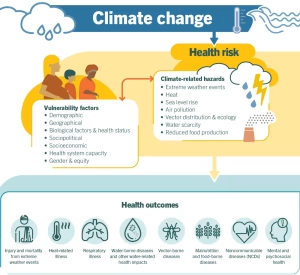No Escape II: The Way Forward – Bringing Climate Solutions to the Frontlines of Conflict and Displacement – ReliefWeb

Report on Forced Displacement and its Intersection with Sustainable Development Goals
1. Global Displacement Crisis: A Challenge to SDG 16
- By mid-2025, the number of individuals forcibly displaced by conflict, violence, and persecution exceeded 117 million, representing a significant challenge to the achievement of SDG 16 (Peace, Justice and Strong Institutions).
- This crisis is compounded by climate-related events, creating complex humanitarian emergencies that threaten global stability and development.
2. The Climate-Conflict Nexus: A Threat to SDG 13 and SDG 16
The convergence of climate-related hazards and conflict is a primary driver of displacement, directly impacting SDG 13 (Climate Action) and further destabilizing fragile regions in contravention of SDG 16.
Key Displacement Statistics:
- Over the past decade, weather-related disasters have caused approximately 250 million internal displacements.
- This represents an average of over 67,000 displacements per day, a 10 percent increase compared to the ten-year average through 2023.
- The number of countries reporting displacement from both conflict and disasters has tripled since 2009, indicating a worsening trend.
Case Study: Chad
- Chad hosts over 1.4 million refugees and asylum-seekers and is classified as one of the world’s most fragile and climate-vulnerable countries.
- In 2024, floods triggered over 1.3 million internal displacements, a figure higher than the previous 15 years combined, illustrating the severe impact on nations striving for climate resilience and institutional stability.
3. Compounded Vulnerabilities and Setbacks for Multiple SDGs
The high exposure of displaced populations to climate hazards undermines efforts to achieve broader sustainable development, particularly for SDG 1 (No Poverty), SDG 10 (Reduced Inequalities), and SDG 11 (Sustainable Cities and Communities).
Exposure to Climate Hazards:
- As of June 2025, over 86 million displaced people were living in countries with high-to-extreme exposure to climate-related hazards.
- Many large refugee settlements (e.g., in Kenya, Ethiopia, Jordan, Bangladesh) are situated in areas experiencing more extreme weather conditions than their host countries, jeopardizing progress on SDG 3 (Good Health and Well-being).
- This combination of high exposure, heightened vulnerability, and low adaptive capacity undermines efforts to build self-reliance and resilience.
Impact on Humanitarian Response and Development:
- In 2024 alone, one-third of emergencies declared by UNHCR were due to the impacts of extreme weather on populations already displaced by conflict.
- This dual pressure deepens marginalization and compounds vulnerability for both displaced populations and host communities.
- These conditions create significant barriers to achieving the 2030 Agenda for Sustainable Development, as they erode the capacity of individuals and communities to escape poverty and inequality.
1. Which SDGs are addressed or connected to the issues highlighted in the article?
The article highlights issues of forced displacement due to conflict, violence, and climate-related disasters, which directly connect to several Sustainable Development Goals (SDGs). The analysis identifies the following relevant SDGs:
- SDG 1: No Poverty – The article discusses how displacement undermines efforts to build self-reliance and resilience, deepens marginalization, and compounds vulnerability for both displaced populations and host communities, pushing them further into poverty.
- SDG 10: Reduced Inequalities – The core issue of the article is forced displacement, which affects vulnerable groups like refugees and asylum-seekers. This relates to the goal of reducing inequalities within and among countries, particularly concerning the rights and well-being of migrants and displaced persons.
- SDG 11: Sustainable Cities and Communities – The article mentions large refugee settlements and host communities that are under pressure from displacement and climate impacts. This connects to the goal of making human settlements inclusive, safe, resilient, and sustainable, especially in the face of disasters.
- SDG 13: Climate Action – This is a central theme, as the article explicitly links climate change, extreme weather events (floods, storms, drought), and gradual changes (sea level rise, desertification) to the increase in displacement. It emphasizes the need for resilience and adaptive capacity.
- SDG 16: Peace, Justice and Strong Institutions – The article begins by stating that tens of millions are forced to flee their homes due to conflict, violence, and persecution. This directly relates to the goal of promoting peaceful and inclusive societies and reducing all forms of violence.
2. What specific targets under those SDGs can be identified based on the article’s content?
Based on the issues discussed, several specific targets under the identified SDGs are relevant:
-
SDG 1: No Poverty
- Target 1.5: “By 2030, build the resilience of the poor and those in vulnerable situations and reduce their exposure and vulnerability to climate-related extreme events and other economic, social and environmental shocks and disasters.” The article directly addresses this by highlighting how over 86 million displaced people live in countries with high exposure to climate hazards and have low adaptive capacity, which undermines their resilience.
-
SDG 10: Reduced Inequalities
- Target 10.7: “Facilitate orderly, safe, regular and responsible migration and mobility of people, including through the implementation of planned and well-managed migration policies.” The article describes the opposite scenario: forced, unsafe, and unplanned displacement due to conflict and climate disasters, indicating a failure to meet this target.
-
SDG 11: Sustainable Cities and Communities
- Target 11.5: “By 2030, significantly reduce the number of deaths and the number of people affected and substantially decrease the direct economic losses relative to global gross domestic product caused by disasters, including water-related disasters, with a focus on protecting the poor and people in vulnerable situations.” The article’s mention of 250 million internal displacements due to weather-related disasters over a decade and 1.3 million in Chad from floods in a single year directly relates to the “number of people affected” by disasters.
-
SDG 13: Climate Action
- Target 13.1: “Strengthen resilience and adaptive capacity to climate-related hazards and natural disasters in all countries.” The article emphasizes that displaced populations and their hosts have “low adaptive capacity to climate hazards,” which is a direct challenge to achieving this target.
-
SDG 16: Peace, Justice and Strong Institutions
- Target 16.1: “Significantly reduce all forms of violence and related death rates everywhere.” The article’s opening statement that tens of millions are forced to flee “conflict and violence” points to the ongoing failure to meet this target, as displacement is a direct consequence of violence.
3. Are there any indicators mentioned or implied in the article that can be used to measure progress towards the identified targets?
The article provides several quantitative and qualitative data points that can serve as indicators to measure the scale of the problems and track progress toward the identified targets.
-
Indicators for Targets 1.5, 11.5, and 13.1
- Number of people displaced by disasters: The article states that weather-related disasters caused “some 250 million internal displacements” over the past decade. This is a direct measure of the number of people affected by disasters.
- Number of people displaced in a specific event: The figure of “more than 1.3 million internal displacements” triggered by floods in Chad in 2024 serves as a specific event-based indicator.
- Number of vulnerable people exposed to climate hazards: The article mentions that “over 86 million displaced people were living in countries with high-to-extreme exposure to climate-related hazards.” This measures the population’s exposure and vulnerability.
-
Indicators for Targets 10.7 and 16.1
- Number of forcibly displaced people worldwide: The statistic that the number of people displaced by war, violence, and persecution stood at “over 117 million” by mid-2025 is a key indicator of the scale of forced displacement due to conflict and persecution.
- Number of refugees and asylum-seekers in host countries: The mention of Chad hosting “over 1.4 million refugees and asylum-seekers” is an indicator of the scale of cross-border forced displacement.
- Number of countries experiencing concurrent crises: The fact that the “number of countries reporting both conflict and disaster displacement has tripled since 2009” is an indicator of the increasing complexity and intersectionality of crises driving displacement.
4. Create a table with three columns titled ‘SDGs, Targets and Indicators” to present the findings from analyzing the article.
| SDGs | Targets | Indicators |
|---|---|---|
| SDG 1: No Poverty | 1.5: Build resilience of the poor and reduce their vulnerability to climate-related extreme events and other shocks and disasters. | Number of displaced people living in countries with high-to-extreme exposure to climate-related hazards (86 million). |
| SDG 10: Reduced Inequalities | 10.7: Facilitate orderly, safe, regular and responsible migration and mobility of people. | Number of refugees and asylum-seekers in a host country (e.g., over 1.4 million in Chad). |
| SDG 11: Sustainable Cities and Communities | 11.5: Significantly reduce the number of people affected by disasters, with a focus on protecting the poor and people in vulnerable situations. | Number of internal displacements caused by weather-related disasters (250 million over a decade; 1.3 million in Chad in 2024). |
| SDG 13: Climate Action | 13.1: Strengthen resilience and adaptive capacity to climate-related hazards and natural disasters. | Proportion of UNHCR-declared emergencies due to extreme weather events (one-third in 2024). |
| SDG 16: Peace, Justice and Strong Institutions | 16.1: Significantly reduce all forms of violence and related death rates everywhere. | Number of people displaced by war, violence, and persecution (over 117 million). |
Source: reliefweb.int
What is Your Reaction?
 Like
0
Like
0
 Dislike
0
Dislike
0
 Love
0
Love
0
 Funny
0
Funny
0
 Angry
0
Angry
0
 Sad
0
Sad
0
 Wow
0
Wow
0



















































.jpg.webp?itok=0ZsAnae9#)























